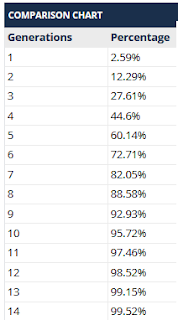My guess at the time was that the Pikholz line split from the other Spiras about nine generations ago. Perhaps a few more. (There are no significant autosomal matches within the above group of seven.)
So what's new?
We have several new developments. First of all, the new Spira tester has upgraded to Y-111 and he is a genetic distance of 3 from "Filip" and me and 4 from Zachy. That is closer to us than the others. The new tester has still not done a Family Finder (autosomal) test, but I would be surprised if he is close enough for an autosomal match.
Second, Family Tree DNA has a new test called Y-700, an upgrade of the Big Y-500. The Y-700 has taken some months because they wanted a new cheek swab. This test is based on Single Nucleotide Polymorphisms (SNPs), as opposed to the Y-37 and Y-111 which are based on Short Tandem Repeats (STRs). In general, STRs are relevant to more recent generations, while SNPs are more ancient. (That is an oversimplification and you can read more about this subject here and at other blogs.)
The big deal about the SNP tests is that while the STR test can assign all of us to the huge R-M269 haplogroup, the SNP tests assign us more sophisticated haplogroups based on what they call the "terminal SNP." These terminal SNPs are outlined in a haplotree structure.
This is the relevant section of the R-M269 haplotree. All these people are part of haplogroup R-FGC20765, which is the way my own haplogroup was defined when we first began talking about SNPs.
Then, about three years ago, some of us were redefined as R-A9700, while the group on the left had its own set of terminal SNPs. I have been graciously guided through the world of SNPs by Rachel Unkefer, who is an administrator of our haplogroup project.
 |
| My paternal and maternal haplogroups as they appear on my FTDNA home page. |
The Y-700 test has identified a new SNP - R-FT56914 - for which three of us (Spira, the new tester and I) have tested positive. The Spiro test is still pending. R-FT56914 is my new terminal SNP and FTDNA shows it on my home page and in the center column of the haplotree above.
The Spiras have a later terminal SNP and they are defined as R-A10520. We have no idea exactly what "later" means, only that it was later than R-FT56914.
This is the newest version of my Y-111 results. "Filip," Zachy and Spiro do not appear in the second column since they have no Y-700 results. (Spiro is, as I said, waiting for his results.)
Since "Filip" and Zachy have not done SNP tests, I cannot know if the new R-FT56914 terminal SNP arose within the last two hundred years which would make it peculiar to me or if it is older and covers all three of us. At some point, perhaps I'll scrape together some budget to run the Y-700 on one of them.
The two at the bottom are from the R-FGC20755 group. They appear in the far left column on the haplotree together with a third man whose Y-111 does not match mine.
Then there is Jerry Simonowits, on the third line from the bottom. He is significantly further from me than the Spiras. He did the Y-700 but, unlike the rest of us, tested negative for the R-FT56914 SNP. So he remains defined as R-A9700 and appears to my right on the haplotree.
This is the TiP report for the closest of the Spiras, based on our Y-111 results. Nine-ten-eleven generations to the common ancestor still looks reasonable.
We are still clearly closer to the Spira/Spiro family than to anyone else.




Are these Spiros levi'im? If so, how do you explain the common Y-DNA?
ReplyDeleteNo. These are not the Cleveland Spiros, who are.
Delete